30 April 2008
Hey neighbour
From Salon: "More and more, the strict new [U.S.-Canada] border rules appear to be a huge cultural and economic mistake. As the United States walls itself off against illegal immigration and terrorism, the relationship between Americans and Canadians will be a casualty."
Keyboard nerdery: the Apple Extended Keyboard II and IBM 101
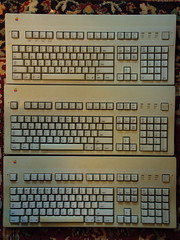 Almost five years ago, I wrote about my favourite keyboards. Alas, things have changed somewhat: most of the links in my original post are broken, and Apple has stopped making the old transparent black-keyed Pro Keyboard and now produces some interesting but very different super-thin models instead (in between, the company made a tolerable but ho-hum white keyboard that also acted as an excellent crumb tray).
Almost five years ago, I wrote about my favourite keyboards. Alas, things have changed somewhat: most of the links in my original post are broken, and Apple has stopped making the old transparent black-keyed Pro Keyboard and now produces some interesting but very different super-thin models instead (in between, the company made a tolerable but ho-hum white keyboard that also acted as an excellent crumb tray).This week, John Gruber and Dan Benjamin wax rhapsodic on their podcast about the ancient Apple Extended Keyboard II, pictured. I have three, as well as two Apple Keyboards (not the Keyboard II) that use the same keys, several miscellaneous USB keyboards, a decent basic PC PS/2 keyboard, and a treasured IBM 101. The 101 is currently hooked up to my eMac with a PS/2-USB adapter, with keys remapped with the Mac's System Preferences.
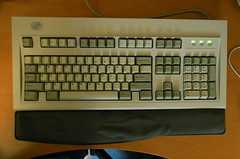 The Extended Keyboard II and the IBM 101 are the twin holy grails of keyboard nerds. Unfortunately, my EKIIs have been sitting in a cupboard for years because I never got around to buying an adapter to make their Apple Desktop Bus (ADB) connectors work with newer USB Macs. But now Gruber and Benjamin may have inspired me to track one down.
The Extended Keyboard II and the IBM 101 are the twin holy grails of keyboard nerds. Unfortunately, my EKIIs have been sitting in a cupboard for years because I never got around to buying an adapter to make their Apple Desktop Bus (ADB) connectors work with newer USB Macs. But now Gruber and Benjamin may have inspired me to track one down.I spent many a year pounding my fingers on an Extended II, in university and as a freelance technical writer. The IBM 101 is a very different beast, also built like a tank but with a more metallic, punchy feel, and an audible note to its astoundingly loud typing sound. As yet no one has been able to replicate what's good about these devices, so if you're a serious computer typist, you'll need to track down a vintage one.
And no, you can't have mine.
29 April 2008
Edited "Spark" interview now available
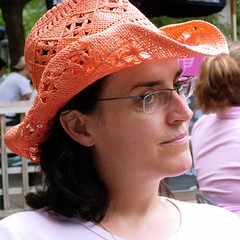 You already heard the full-length unedited version of my interview with Nora Young (pictured) of CBC Radio's "Spark." Now here's the edited version in the latest complete episode of the show, with extra bonus material including me reading some of my blog posts, and my podsafe tune "Striking Silver" as background music.
You already heard the full-length unedited version of my interview with Nora Young (pictured) of CBC Radio's "Spark." Now here's the edited version in the latest complete episode of the show, with extra bonus material including me reading some of my blog posts, and my podsafe tune "Striking Silver" as background music.You can download the whole episode as an MP3 file, or if you're subscribed to the Spark podcast, you'll get it automatically. If you prefer to hear "Spark" on the radio, it airs Wednesday, April 30 (tomorrow) at 11:30 a.m. and Saturday, May 3 at 4:00 p.m. (a half hour later in Newfoundland, of course), on CBC's Radio One network, which is 690 AM in Vancouver. This episode also features internetfamous blogebrities such as Merlin Mann and Amber Mac.
Finally, if you have any doubt at all that "Spark" is a cool show, they just received a promo message recorded by freakin' Strong Bad! How awesome is that? (MP3 also available.)
iPhone coming to Canada, says Rogers
28 April 2008
Vroom vroom!
When it's raining like this outside...
...there's only one thing to do:
Oh yeah, baby!
...there's only one thing to do:
Oh yeah, baby!
27 April 2008
Time for a new Wi-Fi router
Evidence indicates that it is indeed our wireless router at fault for the slug-like behaviour of the Wi-Fi networking in our house. I think this will be a good excuse to purge the ungainly stack of networking gear...
...and replace it with a single wireless router that can do everything with fewer wires and, with luck, less general flakiness. Some of that stuff is only 10BaseT or 10Base2 speed, and has been blinking away in our den closet for a decade.
...and replace it with a single wireless router that can do everything with fewer wires and, with luck, less general flakiness. Some of that stuff is only 10BaseT or 10Base2 speed, and has been blinking away in our den closet for a decade.
26 April 2008
Argh argh argh
Our Internet connection has been painfully slow at home for the past few days. Or so I thought. It turns out that the hardwired connections (like the ancient iMac in the kitchen) are just fine, but the wireless network is behaving very oddly: uploads from our computers to the Net are speedy, downloads crawl. Unfortunately, most stuff (email, web, podcasts) requires downloading more than uploading.
I've tried restarting the AirPort Express that serves as our base station. It shows full bars for signal strength, so that's not a problem. I've tried disconnecting it and hooking up the old flaky Linksys base station—which was still flaky. I've changed the AirPort Express wireless channel, gone to 802.11g only (instead of mixed b/g), turned on Interference Robustness, increased the multicast rate, and so on.
Next I'm going to reset the firmware on the base station. If that doesn't work, I'll see if turning off network encryption, or changing the encryption type, makes a difference. In the meantime, we're mooching off a neighbour's NETGEAR router, which is (strangely) sometimes locked down and sometimes not.
Any other suggestions? This setup has been fine for months and months, so why it's suddenly gooping like molasses I have no idea. Networking remains voodoo, I tell ya.
I've tried restarting the AirPort Express that serves as our base station. It shows full bars for signal strength, so that's not a problem. I've tried disconnecting it and hooking up the old flaky Linksys base station—which was still flaky. I've changed the AirPort Express wireless channel, gone to 802.11g only (instead of mixed b/g), turned on Interference Robustness, increased the multicast rate, and so on.
Next I'm going to reset the firmware on the base station. If that doesn't work, I'll see if turning off network encryption, or changing the encryption type, makes a difference. In the meantime, we're mooching off a neighbour's NETGEAR router, which is (strangely) sometimes locked down and sometimes not.
Any other suggestions? This setup has been fine for months and months, so why it's suddenly gooping like molasses I have no idea. Networking remains voodoo, I tell ya.
Ba-doomp, ba-doomp, ba-doomp, ba-doomp, bom bom!
 Sometime in 1983 or so, I got really into the band Genesis, after the release of their self-titled album of that year. I still look back at that record and its two predecessors from the turn of the '80s, "Duke" and "Abacab," as their best, where they managed to mix art-rock and pop deftly, without turning silly.
Sometime in 1983 or so, I got really into the band Genesis, after the release of their self-titled album of that year. I still look back at that record and its two predecessors from the turn of the '80s, "Duke" and "Abacab," as their best, where they managed to mix art-rock and pop deftly, without turning silly.Yes, I turned into a pretty big fanboy: I went back into the old catalogue and bought the Peter Gabriel-era prog-rock sets too, and I enjoyed them. The later stuff, like "Invisible Touch" and "We Can't Dance"? I think I picked those up more out of duty than pure enjoyment. But I never tired of Phil Collins's drumming, whether on "Selling England By the Pound" or Gabriel's epochal third album or his own solo work. He remains one of the reasons I'm a drummer today.
I saw Collins play live a couple of times, once on the final pre-reunion Genesis tour in the '90s, and once at an arena tour with his solo band. He always put on a good show, with great lighting. At his solo performance, his then-teenaged son sat in on drums, despite having recently broken an arm.
It's not a huge surprise that Collins announced his retirement (via Paul) from recording and performing this week (although whether it will be a Cher/Celine Dion–style retirement or a more real one is an open question). He's been in the entertainment business for something like 45 years—as a child actor he was an extra in A Hard Day's Night—and he certainly has little left to prove.
He's taken his share of slagging over the years, especially when you couldn't avoid him during the '80s, and as he slid into mellow late-period Elton, Rod, and Sting–style music a decade later. But put on a track like "Turn It On Again," "No Self Control," "Misunderstanding," or, of course, "In the Air Tonight"—you can't deny something brilliant there. And he was a pioneer with drum machines and electronic percussion too.
One interesting thing about his drumming: his drum kits have always been set up left-handed. That's unusual even for left-handers like Collins, since so much in drumming requires a kind of ambidexterity. (Ringo Starr, conversely, is also left-handed, but has always played a right-handed kit.) In my case, with a regular right-handed set, I hit the main beats with my left hand, on the snare drum, and my right foot on the bass drum. My right arm handles the hi-hat and most of the other cymbals, and both hands work the tom-toms.
I'm not sure how Collins's reversed setup has affected how he plays, but it certainly hasn't hurt his career. If he doesn't retire fully, I wonder if he might return to his early foray into jazz fusion with Brand X (not that I would actually enjoy that) or something equally strange?
25 April 2008
Full length "Spark" interview available already
 As part of my slightly twisted effort to use my cancer treatment as leverage to get me the kind of exposure and fame my more modest general talents haven't done, I was interviewed on Wednesday for the show "Spark" on CBC Radio (as I've already flogged).
As part of my slightly twisted effort to use my cancer treatment as leverage to get me the kind of exposure and fame my more modest general talents haven't done, I was interviewed on Wednesday for the show "Spark" on CBC Radio (as I've already flogged).You can now hear the full-length talk between me and the always sultry-voiced Nora Young—a voice made even huskier by her fighting a cold at the time. Here's a direct link to the MP3 file (24 minutes, about 33 MB) too. I'll probably link that up at my podcast after the edited version goes to air next week.
I like that "Spark" doesn't have the traditional media attitude of holding on to its source material like a state secret. It's unusual enough for a radio or TV program, publicly funded or not, to post full-length versions of edited interviews online. But to do it days before the final version appears is still more innovative. I'm not sure I'd even do that.
I still think profit beats market share
Way back last decade, in 1999, before this website was even a blog, I wrote an article for MyMac magazine called "Why the Obsession With Market Share?" that said, in part:
Market share alone is pretty meaningless. If Apple can manufacture, market, and sell each of its computers at a profit, then whether it has 2% of 15% of the market doesn't matter at all to whether the company is financially healthy.This week John Gruber makes a similar point. Replace my old mentions of IBM, Compaq, Power Mac G3s, and iBooks with Dell, Motorola, iPods, iPhones, and MacBooks, and you can say plus ça change, plus c'est la même chose.
[...]
Increased market share is a symptom of those results, not the result itself. Keep that in mind the next time a pundit spouts off about Apple's market share -- whether it's rising or dropping -- or when you're tempted to talk about it yourself.
What counts is selling computers and making money doing it, so that Apple Computer will still be around -- to give us Mac users something to buy, and make money doing it -- years down the road.
24 April 2008
Another two weeks, another bottle
22 April 2008
Burnaby's birds, beavers, bogs, and boats
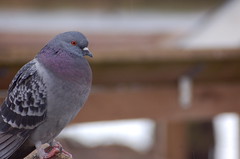 The city of Burnaby, B.C., where I grew up and live, is just to the east of Vancouver itself, and is well known for a significant amount of parks and other green space for such an urban environment. One part of that is Burnaby Lake, a fairly large and extremely shallow wetland in the centre of the municipality.
The city of Burnaby, B.C., where I grew up and live, is just to the east of Vancouver itself, and is well known for a significant amount of parks and other green space for such an urban environment. One part of that is Burnaby Lake, a fairly large and extremely shallow wetland in the centre of the municipality.The lake sits in Burnaby's central valley, and forms part of a waterway that starts at Trout Lake in Vancouver, runs east along Still Creek through Burnaby into the lake, and out into the Brunette River, which flows east and then south through Coquitlam into the Fraser River, which empties westward into the ocean. In recent decades governments have dredged the lake several times, both to provide enough depth for competitive rowing and to avoid having excessive sediment from development and the city's storm sewer system turn the lake into a mudflat—which is why the water's edge is so sharp in the satellite photo.
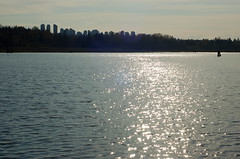 My wife had the great idea of taking the kids on a ten-minute car ride down the hill from our house every few days to check out the waterfowl and other birds, and to see if any chicks have arrived yet this spring. So far they haven't. But there are tons of animals and plants there, from birds such as ducks, Canada geese, crows, and pigeons to carp, frogs, squirrels, and even a significant population of beavers, the world's largest rodent and Canada's mascot.
My wife had the great idea of taking the kids on a ten-minute car ride down the hill from our house every few days to check out the waterfowl and other birds, and to see if any chicks have arrived yet this spring. So far they haven't. But there are tons of animals and plants there, from birds such as ducks, Canada geese, crows, and pigeons to carp, frogs, squirrels, and even a significant population of beavers, the world's largest rodent and Canada's mascot.She's gone down there with them a bunch of times, but this weekend I was feeling well enough to tag along. And a couple of days ago the sunny weather and abundant animals brought out another example of local wildlife: the Canadian wildlife photographer, whose distinctive plumage and plaintive ktsch-ktsch-ktsch-ktch call (known affectionately as the "shutter-and-mirror-slap") were in fine form down at the Piper Spit pier. The next day we visited again (this time one of the girls' school friends joined us), but our bunch was alone because of the cold and rain, which actually turned to snow briefly.
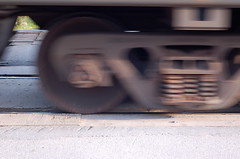 The entrance to that part of the park also crosses some railway tracks, which our daughters enjoy putting pennies on to see if they'll be flattened by passing trains. We're accumulating quite a collection of thin copper ovals now.
The entrance to that part of the park also crosses some railway tracks, which our daughters enjoy putting pennies on to see if they'll be flattened by passing trains. We're accumulating quite a collection of thin copper ovals now.Exactly 20 years ago, in April 1988, I was working a summer job as a park naturalist, headquartered at the nature house at this exact spot, between the railway and the boardwalk. That job was where my wife and I first met. We led canoe tours of the lake some evenings (no motor craft allowed), and this year we're thinking of getting a canoe and taking our kids out there too.
20 April 2008
Out there havin' fun at the Vancouver Sun Run
As I mentioned a few days ago, my band The Neurotics played, for the 15th year in a row, at the Vancouver Sun Run, which as of this year appears to be the largest fun run in North America. There were over 59,000 registrants for the 2008 race.
As part of the photos I took downtown today, here's me behind the drum kit, with Swingy Neurotic (a.k.a. Doug Elliott) on bass:
Thanks to Dilly Neurotic (a.k.a. Sean Dillon) for snapping that one. We all look a bit chubbier than usual because it was freaking cold for late April in Vancouver (just above freezing), so each of us had at least three layers of clothes under our costumes—I was wearing a T-shirt, a long-sleeved shirt, and a chunky sweater underneath my Union Jack shirt and glittery jacket.
Rock on, Sun Runners!
As part of the photos I took downtown today, here's me behind the drum kit, with Swingy Neurotic (a.k.a. Doug Elliott) on bass:
Thanks to Dilly Neurotic (a.k.a. Sean Dillon) for snapping that one. We all look a bit chubbier than usual because it was freaking cold for late April in Vancouver (just above freezing), so each of us had at least three layers of clothes under our costumes—I was wearing a T-shirt, a long-sleeved shirt, and a chunky sweater underneath my Union Jack shirt and glittery jacket.
Rock on, Sun Runners!
19 April 2008
Tabloid magazines annoy me more than they used to
 I know celebrity magazines and tabloids have been around for ages (here's a scandal sheet from 1957), and I've certainly seen them in checkout lines at the grocery store since I was a kid. But lately they—and a lot of their fashion and lifestyle magazine and TV cohorts—are really pissing me off. I think there are a few reasons.
I know celebrity magazines and tabloids have been around for ages (here's a scandal sheet from 1957), and I've certainly seen them in checkout lines at the grocery store since I was a kid. But lately they—and a lot of their fashion and lifestyle magazine and TV cohorts—are really pissing me off. I think there are a few reasons.First of all, they've proliferated wildly over the past decade or so, both directly (more tabloid rags) and indirectly (celebrity gossip appearing in other publications that didn't used to carry it, as well as on countless indistinguishable celebrity hack TV shows). Yet based on what appears on the covers, you'd think there were only maybe two dozen interesting people (Angelina Jolie, Britney Spears, and Paris Hilton, plus people who associate with or resemble them) in the whole world. It's an echo chamber.
Second, I have two daughters approaching adolescence now, and I can see how the relentless repeated messages from these sources could warp their perceptions of what is normal. My wife and I continue to point out the distorted perspectives as part of teaching our kids media awareness, but it's a fair bit of work.
Third is my experience over the past year, specifically with health and weight. Between the beginning of 2007 when I was diagnosed with cancer, and the end of July, I lost over 50 pounds. It's taken more than eight months to gain it back, sometimes requiring me to eat more than I actually want to.
Beforehand, I thought that my stable long-term weight of about 200 pounds (91 kg) was a little higher than it should be, but nothing to be too concerned about. Now 200 pounds seems like a lovely, wonderful weight, a healthy place for me to be, even with all my new lumps and bumps and scars from my treatments and surgeries.
So looking at the shows and magazines that are obsessed with the tiniest weight fluctuations and skin changes in celebrities grinds my teeth. These are trivial, pointless concerns—and what annoys me most is that it's not only obviously what sells, but it also invades my brain when I don't even want it to. Why is there even room in my memory for whether one or the other stick-thin actress has a pregnancy "bump"?
The magazines occasionally find their way into our house. I have occasionally flipped through them, usually in the bathroom. When I do, it's a physically unpleasant experience, like my soul draining out of my body. Ugh, and now it's turning me into a stereotypical grumpy complaining blogger too. See how poisonous these things are?
18 April 2008
The breadth of Ideas
While I'm on this CBC kick, I may as well mention "Ideas," which is surely one of the best radio shows in the world. It has been running in some form or another since 1965.
Every weekday on the radio, and weekly on its podcast, the program spends an hour delving deeply into its title. Its documentary producers talk to politicians, physicians, scientists, theologians, philosophers, poets, artists, writers, historians, and others about topics as diverse as China's 15th century naval fleet, the modern relevance of Don Quixote, theoretical physics, Picasso and the musical avant-garde in Paris during the 1920s, and golf.
And that's just this week. I heard bits (alas, only bits) of the Chinese navy broadcast last night while I was running errands, and was entranced. I sat in the drugstore parking lot for a few minutes because I couldn't tear myself away.
There is a separate feature page (with RealAudio streams! Who still uses that?) and podcast(with proper MP3s) for the ongoing series "How to Think About Science," which started last year. There are already 17 hours in that group of shows alone.
"Ideas" will grow your brain. I recommend you dedicate some time to it.
Every weekday on the radio, and weekly on its podcast, the program spends an hour delving deeply into its title. Its documentary producers talk to politicians, physicians, scientists, theologians, philosophers, poets, artists, writers, historians, and others about topics as diverse as China's 15th century naval fleet, the modern relevance of Don Quixote, theoretical physics, Picasso and the musical avant-garde in Paris during the 1920s, and golf.
And that's just this week. I heard bits (alas, only bits) of the Chinese navy broadcast last night while I was running errands, and was entranced. I sat in the drugstore parking lot for a few minutes because I couldn't tear myself away.
There is a separate feature page (with RealAudio streams! Who still uses that?) and podcast(with proper MP3s) for the ongoing series "How to Think About Science," which started last year. There are already 17 hours in that group of shows alone.
"Ideas" will grow your brain. I recommend you dedicate some time to it.
What blog posts should I read on the radio?
Now that I'm going to be on the radio, again, "Spark" host Nora Young has asked me to pick a couple of my blog posts that I can read out (at least an excerpt, if it's a longer entry) on air—one related to my cancer treatment, one not. I just did a quick skim through and found a few candidates.
If you have a bit of time, take a look and tell me in the comments which of each type you think might sound good on the radio:
If you have a bit of time, take a look and tell me in the comments which of each type you think might sound good on the radio:
Cancer posts
- Dead man walking
- Know your limit
- Bandages and partners
- Needle boy
- Braveblogging
- My least favourite part of town
Non-cancer posts
- "Crouching Tiger" would have made a better "Star Wars"
- Buying my dad a lens
- How a rotary phone is better than a cell
- Meeting up with the geeks
- My first toolbox
- Getting a good baby passport photo
- My daughter's cool glasses
- Can you make money from blogging and podcasting?
17 April 2008
Spark me up
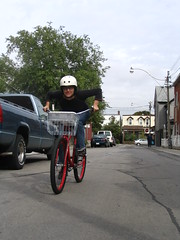 CBC Radio has two programs (also available as podcasts) that confuse me a little: "Spark" and "Search Engine." I like them both, but they seem to cover a lot of the same territory of life in the digital age. Sometimes I can't remember which one had a particular segment—was it host Nora Young at "Spark" who interviewed the guy who edits Hillary Clinton's Wikipedia entry? No, it was host Jesse Brown from "Search Engine."
CBC Radio has two programs (also available as podcasts) that confuse me a little: "Spark" and "Search Engine." I like them both, but they seem to cover a lot of the same territory of life in the digital age. Sometimes I can't remember which one had a particular segment—was it host Nora Young at "Spark" who interviewed the guy who edits Hillary Clinton's Wikipedia entry? No, it was host Jesse Brown from "Search Engine."I suppose it doesn't matter. I'm glad there's enough of an audience for my kind of techie social nerdity that CBC has two shows about it. Yay again to Tod for helping the network get on the podcasting train after jump-starting it with the CBC Unplugged show almost three years ago.
Anyway, I'm going to call "Spark" my favourite of the two shows now, because it looks like I'm going to be on it. Nora—that's her on the bike—indirectly heard about my recent talk on life, death, and my blog, and contacted me through Facebook (appropriately enough) to see if I might like to be on "Spark."
One of my weaknesses is appearing in the media. I've always loved seeing my name in print, or being on the radio or TV. So my immediate thought was, "hell yeah!" We'll likely record something next week for the "Spark" episode airing (and podcasting) at the end of the month. More details to follow.
Incidentally, Nora's other podcast, The Sniffer (not affiliated with the CBC), has been on my subscription list for a couple of years now. I recommend it.
16 April 2008
The Vancouver light
I finally saw Juno tonight. My kids and I watched it on DVD together. Yes, it's a very good movie. You can read the reviews for that.
As somebody who lives in Vancouver, what I really noticed was how obviously Vancouver it is. You can see it in the locations—the residential architecture and subdivisions, the trees and lawns, and especially the light. As in so many things filmed here, like The X-Files and everything else, the light is different from what you see in productions filmed in Los Angeles, New York, Toronto, or other film centres.
It must be the combination of our latitude, weather, proximity to the sea—cloudy or sunny, rain or snow—it looks like here. Maybe Seattle might look similar, yet somehow things filmed there don't look the same.
Does anyone have a line on why that might be?
As somebody who lives in Vancouver, what I really noticed was how obviously Vancouver it is. You can see it in the locations—the residential architecture and subdivisions, the trees and lawns, and especially the light. As in so many things filmed here, like The X-Files and everything else, the light is different from what you see in productions filmed in Los Angeles, New York, Toronto, or other film centres.
It must be the combination of our latitude, weather, proximity to the sea—cloudy or sunny, rain or snow—it looks like here. Maybe Seattle might look similar, yet somehow things filmed there don't look the same.
Does anyone have a line on why that might be?
15 April 2008
After a year and a half, Stanley Park surprised me
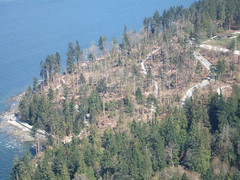 With all my cancer treatments and so on, I have, remarkably, not been to Vancouver's famous Stanley Park since the vicious windstorm that hit Greater Vancouver near the end of 2006, a year and a half ago.
With all my cancer treatments and so on, I have, remarkably, not been to Vancouver's famous Stanley Park since the vicious windstorm that hit Greater Vancouver near the end of 2006, a year and a half ago.Having been born and raised in this city, I think that's the longest time I've ever been away from the park in my entire life, until today. I was downtown for an errand, and decided to take a side trip in the car to drive through the park and see how things were going.
I was astonished. Toppled trees are still everywhere, and the stretch of Park Drive from Prospect Point to Third Beach is unrecognizable. What I always knew as a dense rainforest overhanging the road now comprises steep, open vistas across hundreds of broken trunks down to the ocean.
Rebecca at Miss604.com has been documenting the changes since the storm hit, so I had some idea what to expect—but not really. I'd like to take my bike down there sometime in the next few months and explore the trails again. In many ways, it's a whole different place now.
14 April 2008
Join The Neurotics for the Sun Run next Sunday
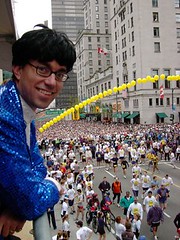 Back in 1994, I was making a go of it as a full-time rock and roll drummer, and my cover band The Neurotics managed to snag a spot along the route of the annual Vancouver Sun Run, where we got paid a bit of money and had the chance to entertain tens of thousands of people as they ran 10 km through Stanley Park.
Back in 1994, I was making a go of it as a full-time rock and roll drummer, and my cover band The Neurotics managed to snag a spot along the route of the annual Vancouver Sun Run, where we got paid a bit of money and had the chance to entertain tens of thousands of people as they ran 10 km through Stanley Park.We were pretty silly (as we always are), and the runners liked us, so somehow the next year we were recruited to play on the scaffold above the starting line for the race, downtown at Burrard and Georgia streets. We've been the band there ever since (among numerous others along the route), and next Sunday, April 20, 2008, marks our 15th appearance at the Sun Run. (The band's lineup varies a bit each year, but for once the group of four musicians will all be guys who've done this show before.)
It's a strange gig, and one of the reasons the organizers keep calling us back is that we've honed our ability to play what guitarist Sean calls "heads-up hockey" up on the temporary stage. We have to show up before 5:00 a.m. to beat the road closures, haul our gear up some rickety scaffold stairs, do a very quick setup, and then go get some breakfast. Once we start playing around 7:30, it's pretty much a continuous performance until all 50,000-plus runners and walkers have gone by. That takes several hours.
But while we're up there playing much of that time, there are a lot of stops and starts, dictated on the fly by the race organizers and announcers on the platform with us—and we get little warning. Sometimes we only play 30 seconds of a song. Others we get 10 seconds (or less) of warning that we'll have to stop another, or just as much notice that we have to start. The mayor might speak, or other local celebrities. There are speeches and announcements, and each group of runners has its own starting announcement and air horn. A group of Fitness World aerobics types helps everyone get warmed up. We need to fit into the gaps, so we learned years ago that a set list does little good.
It is an awesome thing to see tens of thousands of Vancouverites thronging the streets below. It's also a huge load of fun. I was unable to play last year because it was early in my combined radiation and chemotherapy treatments. This year the timing is better, so while I'll be tired, I expect to be able to play the show without a hitch.
If you're in downtown Vancouver early on Sunday morning—especially if you're running by on Georgia Street in front of the RBC tower—look up, way up, and maybe you'll see me bangin' like Charlie Watts. But I'll probably be too busy to wave.
12 April 2008
A montage of montages
This compilation of obsessive fan supercuts is officially awesome. Here's my favourite so far, but I haven't watched them all yet. Or maybe it's this one.
Bomb days
A few days ago I wrote about the 50th anniversary of the Ripple Rock detonation, which sent me hunting around the Web for information. Inevitably, I came across lots of pictures of explosions of all sorts.
I think many people in a broad cohort around my age (38), who grew up during the Cold War, have a morbid fascination with photos of nuclear bomb tests. Some of them are chillingly, starkly, awfully beautiful, especially this set from the French Licorne ("Unicorn") test in the Pacific in 1970:
Reports say that the day of the Licorne detonation had "cloudy conditions but good visibility," but notice how the bomb's shockwave punches right through those clouds, sweeping them entirely away and leaving blue sky in the later pictures. Scary.
Of the hundreds of above-ground nuclear detonations by the U.S., the U.S.S.R., the U.K., France, and China between 1945 and 1980, no two seem to have looked the same. The photographs that freak me out the most are those where the surrounding landscape (and thus the scale) is clear. Or where soldiers walk towards a mushroom cloud in the Nevada desert.
China performed the last atmospheric test of a nuclear weapon almost 28 years ago—these sorts of photos are all, thankfully, now historical. But North Korea conducted what may have been a failed atomic explosion uderground as recently as 2006.
So those mushroom-cloud images don't worry me like they used to when I was a kid. But the worry isn't entirely gone either, is it?
I think many people in a broad cohort around my age (38), who grew up during the Cold War, have a morbid fascination with photos of nuclear bomb tests. Some of them are chillingly, starkly, awfully beautiful, especially this set from the French Licorne ("Unicorn") test in the Pacific in 1970:
Reports say that the day of the Licorne detonation had "cloudy conditions but good visibility," but notice how the bomb's shockwave punches right through those clouds, sweeping them entirely away and leaving blue sky in the later pictures. Scary.
Of the hundreds of above-ground nuclear detonations by the U.S., the U.S.S.R., the U.K., France, and China between 1945 and 1980, no two seem to have looked the same. The photographs that freak me out the most are those where the surrounding landscape (and thus the scale) is clear. Or where soldiers walk towards a mushroom cloud in the Nevada desert.
China performed the last atmospheric test of a nuclear weapon almost 28 years ago—these sorts of photos are all, thankfully, now historical. But North Korea conducted what may have been a failed atomic explosion uderground as recently as 2006.
So those mushroom-cloud images don't worry me like they used to when I was a kid. But the worry isn't entirely gone either, is it?
11 April 2008
Thank you, Mario Party
My hope that I wouldn't see a repeat of my chemotherapy vomiting from a couple of weeks ago didn't come to pass: last night I had one of those face-squeezing barfs that feels like it would come out my eyes if I could even keep them open. But it only happened once, then I felt a bit better, slept for hours and hours, and this morning was awake and feeling semi-decent by 8 a.m.
UPDATE: After a pretty good day overall, I puked again Friday night around 7, but it wasn't as bad as yesterday. I feel much better after that.
I also find that playing Mario Party 8 is a great distraction, even by myself. It's easy and random enough that I can't get too worked up about it, but it's fun and takes my mind off the various poisons coursing through my body until tomorrow afternoon. My wife and I might even try playing it again, without our daughters for a change. The kids take it a little more seriously than we do.09 April 2008
A tear for Wally's Burgers
 About 20 years ago, when my roommate Sebastien and I were first learning to play in a rock band, he wrote a song whose chorus was:
About 20 years ago, when my roommate Sebastien and I were first learning to play in a rock band, he wrote a song whose chorus was:Wally's Burgers is the place to goWally's has been a drive-in burger joint on Kingsway in Vancouver since the 1950s (it changed its name to Wally's in 1962). A couple of weeks ago I dropped by to grab one of their delicious Deluxe Wagon burgers, but the place was packed, so I went elsewhere.
Wally's Burgers is the place to go
Wally's Burgers is the place to go
Let's go!
I only found out this week that was because Wally's closed forever at the end of March, so my last meal there had actually been a couple of months ago. A few days ago my wife and I noticed that the famous neon sign had come down, and today I drove past to see the windows boarded up. It's a shame. The burgers really were extremely good.
For someone born and raised in this city, I discovered Wally's surprisingly late, in the 1980s, but I was hooked. Over my years of commuting by bicycle along Kingsway, first to university and then to work downtown, I've eaten innumerable Chuck Wagon burgers and fries there.
There are other tasty hamburgers in Vancouver, but none quite the same as Wally's. As far as I know there has only ever been the one location—but had its owners taken a different business approach, I think Wally's could have been a B.C.-wide institution like White Spot.
At least we still have Me-n-Ed's Pizza. In fact, I ate some three days ago.
UPDATE: As of spring 2009, Wally's has two new locations opened by new owners of the names and recipes, one at the Cates Park concession in North Vancouver, and one in Killarney Village in East Vancouver, not too far from the original Kingsway restaurant.
Flickr does video
The Neurotics Fab Rock Invasion
Originally uploaded by penmachine
The key thing is that videos uploaded to Flickr must be less than a minute and a half long, and no bigger than 150 MB. That's a limitation, but also a gift. It forces you to think about what to upload, and if you have a longer video, to edit it down to its essence.
My first video upload there is a good example. I had to take a video of my band that was already only a few minutes long and make it even shorter. I had to cut out non-licensed music and any other extraneous bits. In the end it's only one minute, but it still gets the point of our act across, even without any singing at all.
I think the time limit will generate some creativity in the Flickr community, as well as avoiding those interminable videos that take forever to get to the point. Even if a video is bad, you'll only have to waste 90 seconds on it. We'll see what happens within the well-imagined constraints.
08 April 2008
Whole lotta lip gloss
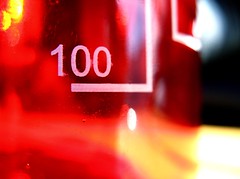 I didn't really get podcasting at all until the middle of 2005, which was some months after the technology first appeared in late 2004—and right about the time iTunes started supporting it. The first person to start a real podcast in our family was my wife, who launched Lip Gloss and Laptops with her friend KA in March 2006.
I didn't really get podcasting at all until the middle of 2005, which was some months after the technology first appeared in late 2004—and right about the time iTunes started supporting it. The first person to start a real podcast in our family was my wife, who launched Lip Gloss and Laptops with her friend KA in March 2006.Their show has now reached its 100th episode. That would be a milestone in any medium, but in podcasting it's a big one. A good percentage of podcasts podfade and stop publishing long before their 100th show. Others, like my my personal podcast and the other one I co-host, publish irregularly and so take a long time to rack up the numbers (despite starting back in 2005, Inside Home Recording hasn't even reached episode 60 yet).
But other than a few holidays over Christmas and such, Lip Gloss and Laptops has come out every Wednesday for over two years. Even if you're not into the beauty and cosmetics industry, which it covers, it's an interesting and informative listen. (As the show's audio engineer, I hear every episode.)
So congratulations to Airdrie and Kerry Anne on their 100th show. I'm sure they'll be hearing lots more cheers from their fans around the world too.
07 April 2008
Lovely aerial night city photos from Doc Searls
Check out this beautiful set of pictures of city lights from Doc Searls. He took them while flying on a commercial jet up the U.S. East Coast:
It's a shame that we waste so much energy radiating light out into space, but it's pretty.
It's a shame that we waste so much energy radiating light out into space, but it's pretty.
06 April 2008
The Boot and Blade figure skating blog should cover the 2010 Olympics
Figure skating's not really my thing, but blogging is, and my mom sure loves the sport. Blogging colleague Julie has a figure skating blog over at BootAndBlade.com, and she is trying to get media accreditation for the 2010 Olympics here in Vancouver.
I think bloggers should totally be there in the media scrum, so as her husband Darren has requested, if you have a website and link over to her site (such as to her worst falls in figure skating post), it will help.
I think bloggers should totally be there in the media scrum, so as her husband Darren has requested, if you have a website and link over to her site (such as to her worst falls in figure skating post), it will help.
05 April 2008
Fifty years after Ripple Rock
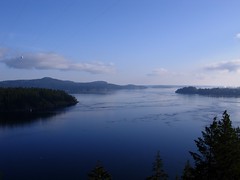 Back in the late 1950s, my mom worked for CBC Television here in Vancouver. One of the biggest events the network covered at that time took place 50 years ago today in the waters near Campbell River, B.C. on Vancouver Island: the Ripple Rock detonation, one of the largest artificial non-nuclear explosions ever created.
Back in the late 1950s, my mom worked for CBC Television here in Vancouver. One of the biggest events the network covered at that time took place 50 years ago today in the waters near Campbell River, B.C. on Vancouver Island: the Ripple Rock detonation, one of the largest artificial non-nuclear explosions ever created.As described (and diagrammed) at The Taming of the Rock, the project was a huge effort, designed to remove the deadly navigation hazard of an underwater mountain in the middle of the Inside Passage. Nearly 1400 tons of Nitramex explosives were packed into chambers dug into Ripple Rock's twin peaks—not from above, but by miners who dug a vertical channel down to bedrock on neighbouring Maud Island, then a horizontal one underneath the seafloor across to Ripple Rock, then up again to the blast zones. Like a root canal. The digging took more than two years.
The explosion itself shortened the underwater peaks by almost 12 metres, making the channel at Seymour Narrows much more navigable and reducing some of the fearsome tidal currents and whirlpools that Ripple Rock used to generate. (The tides in this part of the world are some of the most powerful on earth anyway—in a shallow constriction, they can be as fierce as a whitewater river.)
You can watch CBC TV's archived live coverage of the event from April 5, 1958. My mother's friend Erlyne was one of the few women on that TV crew, though she's not part of the recording. She and my mom met at the CBC, and are still friends 50 years later.
Crazy crazy Steinway Lyngdorf speakers
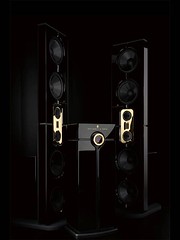 These seven-foot-high, 500-pound Steinway Lyngdorf speakers apparently sound pretty amazing. They look cool too.
These seven-foot-high, 500-pound Steinway Lyngdorf speakers apparently sound pretty amazing. They look cool too.They'd better, for $150,000. They remind me a bit of an advertisement I saw perhaps 25 years ago in one of my mom's copies of Architectural Digest magazine. I still remember the ad copy almost perfectly:
When your neighbor asks where he can get an Aston Martin Lagonda like yours, tell him he probably can't.(Coincidentally, back in 1976 when that particularly ugly Aston Martin model was introduced, it also cost $150,000.)
Anyway, the same Steinway magazine in which I read about the speakers featured pianos, of course, but also luxury wooden boats, high-end Swiss watches, and even (in an ad my wife spotted) custom-bred dogs.
I wonder what percentage of people who spend hundreds of thousands of dollars on a Steinway piano actually play it very often?
04 April 2008
Chevron's gas pumps piss me off
This has bothered me for years. A couple of days ago I fueled up one of our cars at a Chevronstation. Here is their self-serve gas pump:
I'd like you to notice something—Chevron is trying to trick you. The lowest-priced fuel (87 octane) is on the far right. The price gets higher as you go left, with the highest-priced Supreme Plus fuel (94 octane) having its own separate nozzle, which is coloured bright red, on the far left side of the payment console. (The nozzle for the other grades is a subtle blue.)
I can think of only one reason for that, and it's one that's hostile to Chevron's customers. In a society where we read left to right, and would normally expect prices to go from low on the left to high on the right, this pump is designed to bamboozle drivers who are in a hurry and not paying close attention. In a rush, they press what they intuitively assume would be a lower-priced button (on the left), but actually get a higher-priced blend instead. That happened to me a few times when Chevron first introduced this style of pump a decade or two ago.
Worse, if you're particularly distracted, the pump for Supreme Plus can look like a separate single nozzle, and it's possible to pick the most expensive fuel without realizing it until it's too late. Up on the big price sign next to the station, we generally only see the price for the lowest-cost fuel, but the pumps themselves conspire to fool you into buying something that costs more. It's not a big thing to pay attention to if you want to avoid the ruse, but I notice a bit of a cognitive load when I encounter it. And of course, the digital price indicators have the smallest print in each section; you can hardly even see them in my photo.
Most modern economy cars—which is what most Canadians, like my family, drive—don't require anything more than the basic grade fuel. I fully expect that gas stations sell far more of that standard grade than their higher-priced varieties, so the design of pumps ideally should make it easy for the majority of people to find what they want. It might make the most sense for standard 87-octane blend to be the one with its own nozzle, and for the price to go up left to right overall. But that's not what's happening here.
Overall, Chevron is no more or less controversial than other oil companies. I like their claymation commercials and their Town Pantry convenience stores. But because of this pump design problem, I usually don't buy my gas at their stations.
I'd like you to notice something—Chevron is trying to trick you. The lowest-priced fuel (87 octane) is on the far right. The price gets higher as you go left, with the highest-priced Supreme Plus fuel (94 octane) having its own separate nozzle, which is coloured bright red, on the far left side of the payment console. (The nozzle for the other grades is a subtle blue.)
I can think of only one reason for that, and it's one that's hostile to Chevron's customers. In a society where we read left to right, and would normally expect prices to go from low on the left to high on the right, this pump is designed to bamboozle drivers who are in a hurry and not paying close attention. In a rush, they press what they intuitively assume would be a lower-priced button (on the left), but actually get a higher-priced blend instead. That happened to me a few times when Chevron first introduced this style of pump a decade or two ago.
Worse, if you're particularly distracted, the pump for Supreme Plus can look like a separate single nozzle, and it's possible to pick the most expensive fuel without realizing it until it's too late. Up on the big price sign next to the station, we generally only see the price for the lowest-cost fuel, but the pumps themselves conspire to fool you into buying something that costs more. It's not a big thing to pay attention to if you want to avoid the ruse, but I notice a bit of a cognitive load when I encounter it. And of course, the digital price indicators have the smallest print in each section; you can hardly even see them in my photo.
Most modern economy cars—which is what most Canadians, like my family, drive—don't require anything more than the basic grade fuel. I fully expect that gas stations sell far more of that standard grade than their higher-priced varieties, so the design of pumps ideally should make it easy for the majority of people to find what they want. It might make the most sense for standard 87-octane blend to be the one with its own nozzle, and for the price to go up left to right overall. But that's not what's happening here.
Overall, Chevron is no more or less controversial than other oil companies. I like their claymation commercials and their Town Pantry convenience stores. But because of this pump design problem, I usually don't buy my gas at their stations.
03 April 2008
Farewell to the Lab
 Back in February when my podcast co-host Paul and I made our most recent trip down to the Lab With Leostudios here in Vancouver, no one knew that it would be the last shooting week ever for the show. But not long afterwards, Leo Laporte emailed to tell us it was the end of the line: after ten years of creating Call for Help and The Lab for TV in the U.S. and Canada, it had been cancelled.
Back in February when my podcast co-host Paul and I made our most recent trip down to the Lab With Leostudios here in Vancouver, no one knew that it would be the last shooting week ever for the show. But not long afterwards, Leo Laporte emailed to tell us it was the end of the line: after ten years of creating Call for Help and The Lab for TV in the U.S. and Canada, it had been cancelled.It's a pity that a tech show like The Lab, which covers a wide variety of topics and doesn't talk down to its audience, couldn't survive—or even get U.S. distribution. Fortunately, Leo (who has been covering technology on radio and TV for decades, and has even won an Emmy award) isn't standing still, and plans to launch an online version of the show in the next few weeks from his studio in Petaluma, California (also, incidentally, the town where Mesa-Boogiemanufactures its guitar amplifiers).
As far as Inside Home Recording goes, we've started posting tutorials over at IHR TV, which may later include some live-action explanatory episodes like our segments on The Lab. And though it's far less convenient than driving a few minutes across Vancouver, if we ever find ourselves in California wine country, we might appear on Leo's new show down there too.
02 April 2008
Did humans kill off the woolly mammoth?
 There's long been speculation that as humans moved into Arctic territories (as well as into North America), we were primarily responsible for the extinction of the woolly mammoth about 12,000 years ago. Other researchers have favoured climate change at the end of the Pleistocene era as the main reason they disappeared.
There's long been speculation that as humans moved into Arctic territories (as well as into North America), we were primarily responsible for the extinction of the woolly mammoth about 12,000 years ago. Other researchers have favoured climate change at the end of the Pleistocene era as the main reason they disappeared.New research indicates that, in Eurasia at least, the answer is probably both. Mammoth populations fluctuated hugely throughout the Pleistocene, dropping to levels even lower than their pre–human contact point as much as 125,000 years ago, during a warming period.
But when humans entered the picture millennia after that, as the Ice Age glaciers were melting, mammoth populations were again low, and our hunting activity likely slowly picked the big pachyderms off.
The last woolly mammoths to die off were amazingly recent: a dwarf variety survived until less than 4,000 years ago on Wrangel Island, in the Arctic Ocean off the desolate far northeast coast of Siberia. That human hunting had a role in their demise is no surprise: quite often, when our species has moved into new areas (especially isolated ones), we exterminate species that live there, especially large yummy ones.
Maoris eliminated moas from New Zealand not long after arriving between 800 and 1300 A.D. (moas were gone by 1500, a couple of hundred years before Europeans started showing up). Similarly, dodos disappeared in the late 1600s after humans arrived on their home island of Mauritus. And we're doing an effective job of bringing a variety of big species, from blue whales to Siberian tigers—and many other organisms too—close to the vanishing point today. Only rarely, as in the case of the smallpox virus, do we do it on purpose.
It's possible that woolly mammoths might have disappeared even without us as the Ice Age ended. But we very likely speeded their extinction along.
01 April 2008
Links of interest (2008-04-01):
A couple of interesting links from friends of mine today (nope, neither is an April Fool's joke):
First, Dave pointed me to tweetcloud.com, which aggregates Twitter posts into a tag cloud. Here's mine:
Funny, one of the words listed there is "cheng," which only appears because when I type Twitter posts on my iPod Touch, it tries to spell-correct "chemo" to "Cheng." That's annoying when it happens.
Second, Bill linked to an article in the New York Times noting that:
First, Dave pointed me to tweetcloud.com, which aggregates Twitter posts into a tag cloud. Here's mine:
Funny, one of the words listed there is "cheng," which only appears because when I type Twitter posts on my iPod Touch, it tries to spell-correct "chemo" to "Cheng." That's annoying when it happens.
Second, Bill linked to an article in the New York Times noting that:
In the 17th century, China and India accounted for more than half the world’s economic output. After a modest interlude, the pendulum is swinging back to them at a speed the West has not grasped.Some would argue that the overall pattern of human history since the invention of agriculture has been a long, slow march to the eventual ascendancy and dominance of China. It may be true.
Camcorders have changed in 10 years
 Over at Inside Home Recording, we recently started IHR TV, additional short video tutorials that augment our regular longer audio podcasts. As part of that effort, we used some of the money we get from sponsors and advertisers to buy two Panasonic HDC-SD5 high-definition camcorders. (Bought online, two of them cost only very slightly more than a single one at local retail stores.)
Over at Inside Home Recording, we recently started IHR TV, additional short video tutorials that augment our regular longer audio podcasts. As part of that effort, we used some of the money we get from sponsors and advertisers to buy two Panasonic HDC-SD5 high-definition camcorders. (Bought online, two of them cost only very slightly more than a single one at local retail stores.)The last camcorder my family had, which sits half-broken in our basement, was an old Samsung analogue Video 8 tape-based machine, from 1998. Given the improvements in other consumer electronics, from personal computers to digital cameras to televisions, over the past decade, I'm not sure why I'm so surprised at this little camcorder, but it's a remarkable machine.
Consider, first, that it can record at 1920x1080i "Full HD" resolution, with something like six times the detail of our old camera, using a very nice mechanically stabilized Leica lens. It stores that information not on tapes, but on the same SD cards used by the still cameras and audio recorders we have at the house. The whole camera is only about a third larger, and almost exactly the same weight, as the old Samsung battery—being smaller than my hand, it almost gets lost among its accessories in our camcorder bag.
Perhaps most remarkably, Panasonic has put real thought into simplifying how the camera works. There aren't many buttons and dials, they're clearly labeled, and everything is easy enough to figure out that the manual (which is long and detailed, but only averagely written) is only necessary for some of the more detailed settings. The SD5 even takes pretty nice still photos.
Those huge HD videos, however, require a lot of horsepower to edit: only one of the computers in our house (my Intel MacBook) will even import the massive AVCHD video files directly. And, following the trend in pocket still cameras, there is no longer a viewfinder: you have to look at the pop-out LCD screen to frame your shots. Like too many consumer electronics today, the camera also comes festooned with garish and difficult-to-remove little stickers advertising its features, the software it comes with, and so on. I removed those immediately.
It lacks a couple of pro features that would be useful: the only sound-in is from the stereo microphone, so you can't connect an external mic or line-in sound, which is something I'll work around with a separate audio recorder if needed. (Very cleverly, though, the microphones can focus in on your subject as you zoom the lens, and electronically filter out some wind noise. Nifty.) Similarly, while it comes with cables to send sound and video out to a TV or other device, you can't record video from any source other than the lens, so I can't, for instance, use it to digitize any of our old footage.
With devices like these, it's no wonder people can now smuggle broadcast-quality video out of the world's war zones and trouble spots. We'll see what I can do with this camera and my mediocre video skills for our modest little podcast.
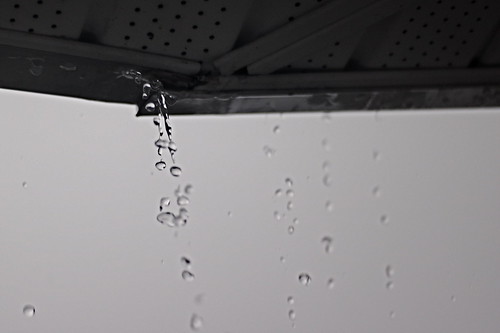

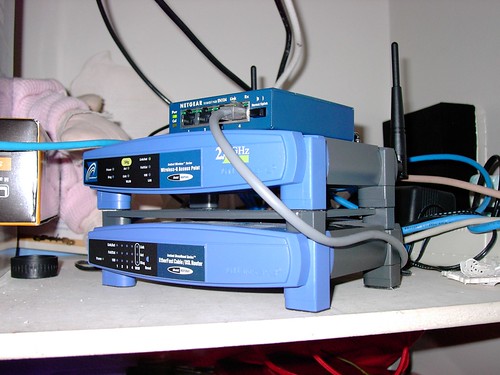


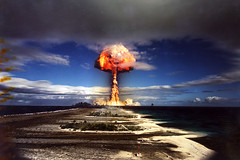
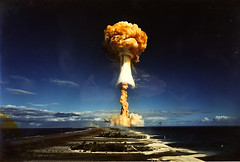
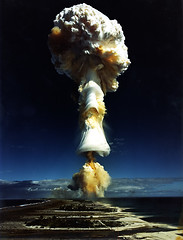

























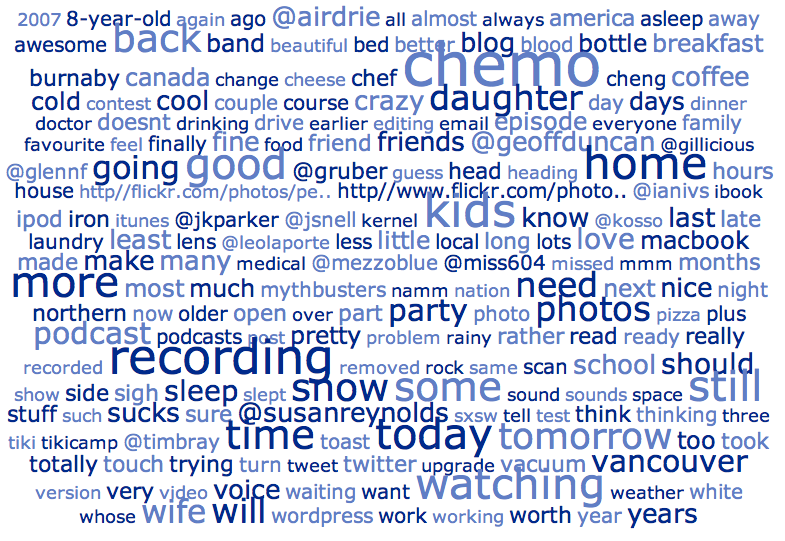
No comments:
Post a Comment